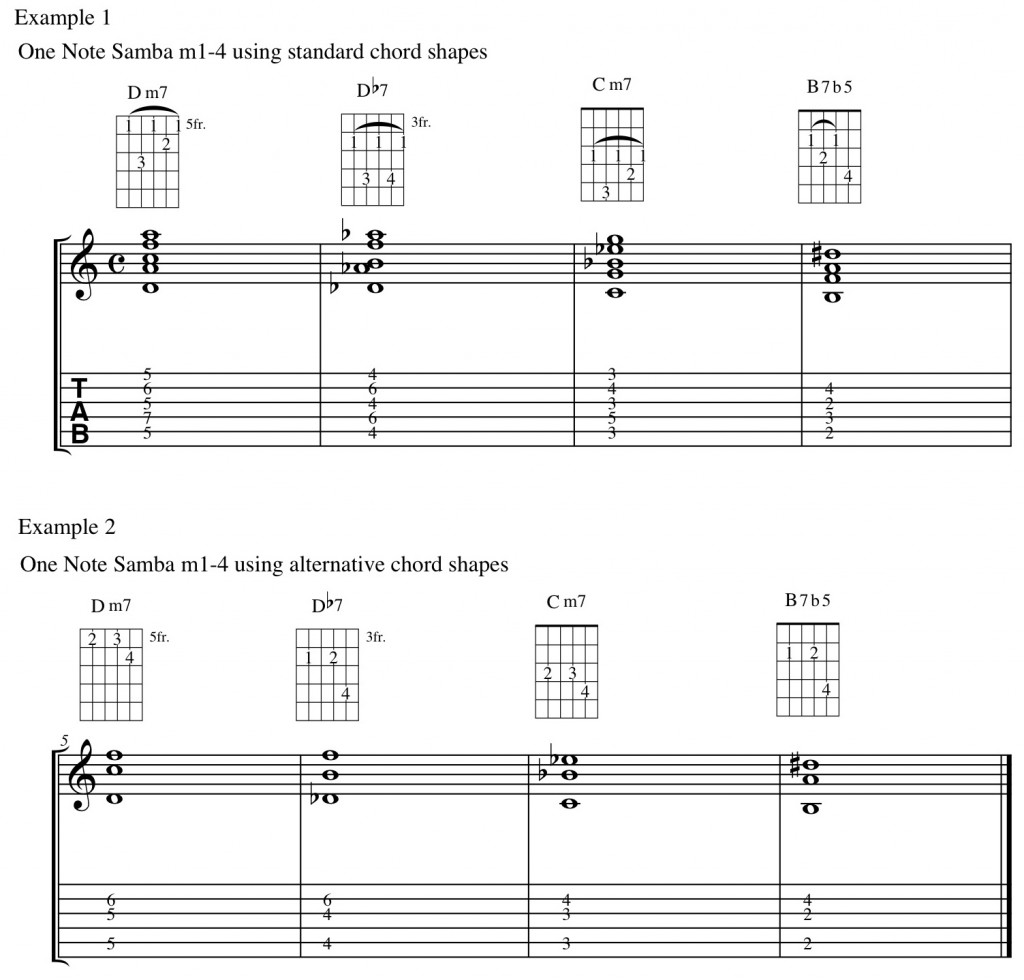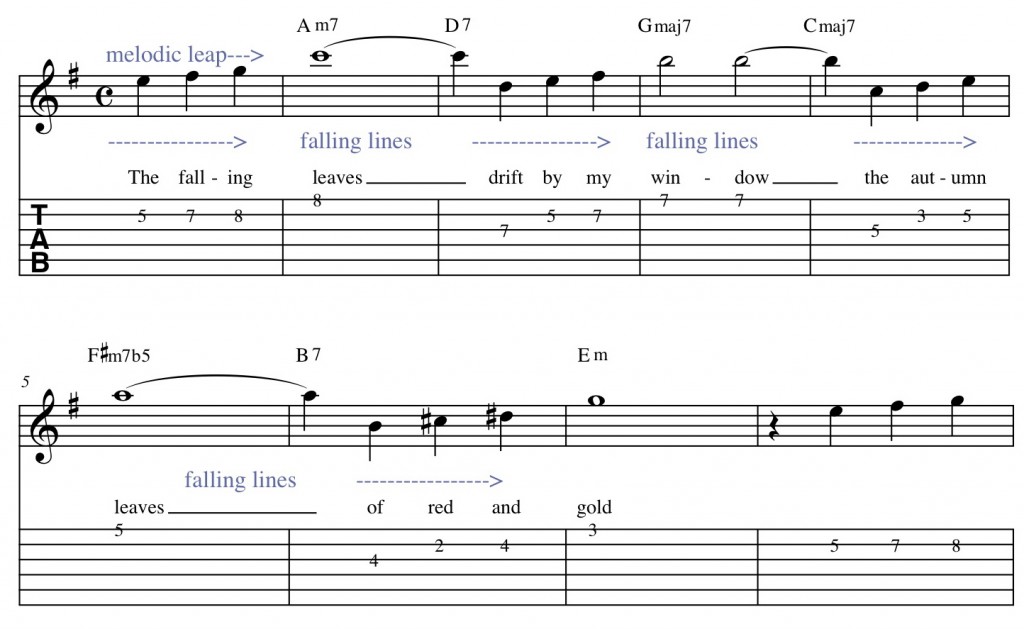In a recent post using the classic song April in Paris, I talked about how you can liven up an arrangement by using chord substitution. Check out this version by Joe Pass for some great examples of this concept by the man himself.
Archives for 2012
One Note Samba and chord shapes
Arming ourselves with a good array of chord shapes to equip us for all situations makes playing through chord progressions a lot more satisfying. While it’s true that you can get away with knowing a small handful of chords, you’ll get more out of the music by investigating different shapes. Take the song One Note Samba for instance. There’s a very distinctive downward chord movement in the first four bars- Dm7 to Db7 to Cm7 to B7b5. I’ve given two examples below which you can take a look at. In example one I’m using the standard chord shapes that are found in most chord books. Using standard chord shapes, we have to employ the use of barre chords. While absolutely acceptable, to my ear, the chord movement sounds a bit disjointed and the actual physicalities of the left hand movement feels awkward (even if you are a master at barre chord shapes). In example two I’ve broken away from the standard chord shapes to give a more flowing nature to both the sound of the chord movement and the actual physical shapes employed by the left hand. Now try playing both and have a think about which you find most satisfying. Employing different left hand shapes is not about learning lots and lots of different shapes, it’s about learning the right shapes, nice sounding shapes and having an understanding of how and when to use them. The other benefit of playing “light” shapes is that it gives us more freedom to embellish the chord tones. If the thought of that excites you then come and join my FREE Beyond Tabs guitar course where we can talk further.
Love For Sale
Clip of me playing with singer Olivia Ennemoser, supporting British Jazz Singer Tina May at the Errigal Arts Festival, Letterkenny, Co Donegal
April in Paris and chord substitution
We can often liven up a chord arrangement, both for oureselves and the listener, by substituting the chords we are playing with other chords. Granted to do this well you have to either have a fair knowledge of harmony or a very good ear. If you’d like to develop either or both of these for yourself then you should come and join my FREE Beyond Tabs guitar course where I look at both of these areas in detail. The best way to demonstrate what I mean by chord substitution is to show you an example. When we are changing the chord that lies under a melody then we have to ensure that the chord fits both in terms of enhancing the melody note and taking us forward in the progression to somewhere where we’d like to be. Take a look at the example below from the Vernon Duke song “April in Paris”.
While the melody in measures 1&2 is identical to that in measures 3&4, Vernon Duke has used to two different sets of chords to harmonise the same melody. As well as forcing us to hear the melody in a different light, the G7 chord substitution also has the purpose of taking us to the first chord in measure 5, Cmaj7. When we see concepts like this in action, often my advice to students is go and learn some songs and try to think a bit about what is happening as this will inform our own creative out pourings. There is a wealth of ideas out there, so go and borrow some !
Pavane Pour Une Infante Defunte
I’m currently working on my own arrangement of Pavane Pour Une Infante Defunte by Maurice Ravel. While I’m writing the arrangement in my own style, as always, it’s really worthwhile to listen to some recordings by others. Check out this arrangement by Julian Bream
Autumn Leaves guitar chord progression
Autumn leaves follows a structure of AABC meaning that the first 8 measures “A” (m1-8 ) follow the same structure as the second 8 measures, also named “A” (m9-16). Moving into the middle 8, the chords are as below. Again the chord progression is following a pattern of ascending 4ths
Autumn leaves Guitar Arrangement -Version by Ted Greene
I really like this Ted Greene version of Autumn Leaves. Greene was a guitarist who was known as both an educator and a player. He had a great harmonic knowledge and in particular the ability to apply that knowledge to the guitar. If you subscribe to spotify you should check out his album “Solo Guitar”. In this version of Autumn leaves he drifts into a swing feel using nice internal moving lines and then towards the end of the arrangement he starts to improvise in the style of Bach. Plenty of ideas in there !
Autumn Leaves Chord Progression
For you theory buffs out there I thought I’d like to talk a bit about the structure of the chord progression of Autumn Leaves. The progression of the song follows a pattern of ascending 4ths. What I mean by this is that from the first chord, Am we move to D7. D is 4 steps away from A in the G major scale, the song is in the key of G major (relative minor scale – Em). From D7 we move to G, again 4 scale steps, and then from G to Cmaj7, again 4 scale steps. With a couple of exceptions this is the pattern followed right through the song. The result is that we have progression of great symmetry and balance……maybe comparable to the growth structure of those falling leaves ? Discuss
Learning Songs – Autumn Leaves Melody
Looking at the melody of Autumn leaves, I love the melodic leap write at the pick up. It really grabs your attention. Go back to the previous blog and listen to the way Eva Cassidy embellishes the high note giving it even more energy and tension. The melody as written below is the original melody of the song. Again, listen to the way Eva Cassidy plays with the melody, keeping the central flavour of the melody while at the same time putting her own stamp on it. You can see from the notation below (even if you don’t read notation you’ll still get the idea of the shape of the musical lines) that after the initial leap there is a series of 3 note rising lines that gently fall through the next 8 measures….. a bit like those falling leaves ?
Learning Guitar Songs – Autumn leaves
As I do, I was trolling about the internet looking for versions of Autumn Leaves that could help inspire my arrangement and I’ve got to say this version by Eva Cassidy is definitely up there


